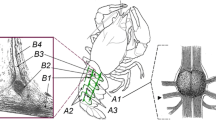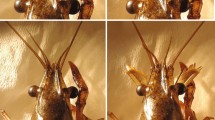Abstract
Recordings were made from the nerve innervating the stretch receptors of the abdominal muscle receptor organs and slow extensor muscles of tethered crayfish, Cherax destructor, during so-called “non-giant swimming”. The stretch receptors were active during the flexor phase of swimming but the duration and pattern of activity varied from cycle to cycle. Their pattern of firing was modified by the activity of the large accessory neurons which make direct inhibitory synapses upon them. Neither the stretch receptors nor the accessory neurons were active during the extensor phase of the cycle. The timing and extent of tailfan movements during the period of stretch receptor activity were measured from video records before and after the stretch receptor nerves were cut in the second to fifth segments. The promotion of the tailfan during flexion was significantly delayed and the minimum angle to which the uropods were remoted at the end of flexion significantly larger in denervated animals. We propose that afferent information from the stretch receptors coordinates the timing and extent of tailfan movements according to variations in the positioning and movement of the abdominal segments such that the hydrodynamic efficiency of the tailfan is enhanced on a cycle by cycle basis during non-giant swimming.






Similar content being viewed by others
Abbreviations
- A#:
-
abdominal segment number
- Acc:
-
accessory neuron
- LUU:
-
large unidentified unit
- MRO:
-
muscle receptor organ
- NGS:
-
non-giant swimming
- SEMN:
-
slow extensor motor neuron
- SR:
-
stretch receptor neuron
References
Alexandrowicz JS (1951) Muscle receptor organs in the abdomen of Homarus vulgaris and Palinurus vulgaris. Q J Microsc Sci 92:163–200
Bastiani MJ, Mulloney B (1988a) The central projections of the stretch receptor neurons of the crayfish: structure, variation, and postembryonic growth. J Neurosci 8:1254–1263
Bastiani MJ, Mulloney B (1988b) The central projections of the stretch receptor neurons of crayfish: segmental gradients of synaptic probability and strength. J Neurosci 8:1264–1272
Cooke IRC, Macmillan DL (1985) Further studies of crayfish escape behaviour. I. The role of the appendages and the stereotyped nature of non-giant escape swimming. J Exp Biol 118:351–365
Drummond JM, Macmillan DL (1998a) The abdominal motor system of the crayfish, Cherax destructor. I. Morphology and physiology of the superficial extensor motor neurons. J Comp Physiol A 183:583–601
Drummond JM, Macmillan DL (1998b) The abdominal motor system of the crayfish, Cherax destructor. II. Morphology and physiology of the deep extensor motor neurons. J Comp Physiol A 183:603–619
Drummond JM, Macmillan DL (2002) The cord stretch receptors in the abdominal nerve cord of the crayfish Cherax destructor: physiology and relationships. J Comp Physiol A 188:349–357
Faulkes Z, Macmillan DL (2002) Effects of removal of muscle receptor organ input on the temporal structure of non-giant swimming cycles in the crayfish, Cherax destructor. Mar Fresh Behav Physiol 35:149–155
Fields HL (1976) Crustacean abdominal and thoracic muscle receptor organs. In: Mll PJ (ed) Structure and function of proprioceptors in the invertebrates. Chapman and Hall, London, pp 65–114
Fields HL, Kennedy D (1965) Functional role of muscle receptor organs in crayfish. Nature 206:1235–1237
Fields HL, Evoy WH, Kennedy D (1967) Reflex role played by efferent control of an invertebrate stretch receptor. J Neurophysiol 30:859–874
Jones KA, Page CH (1986) Postural interneurons in the abdominal nervous system of lobster. I. Organization, morphologies and motor programs for flexion, extension and inhibition. J Comp Physiol A 158:259–271
Larimer JL, Eggleston AC (1971) Motor programs for abdominal positioning in crayfish. Z Vergl Physiol 74:338–402
Macmillan DL (2002) The abdominal muscle receptor organ of crayfish and lobsters: current issues. In: Wiese K (ed) Crustacean experimental systems in neurobiology. Springer, Berlin Heidelberg New York, pp 109–117
Macmillan DL, Patullo BW (2001) Insights for robotic design from studies of the control of abdominal position in crayfish. Biol Bull 200:201–205
Macmillan DL, Vescovi PJ (1997) The muscle receptor organs of the crayfish Cherax destructor : organisation of central projections of stretch receptor neurons. J Exp Zool 279:243–253
McCarthy BJ, Macmillan DL (1995) The role of the muscle receptor organ in the control of abdominal extension in the crayfish Cherax destructor. J Exp Biol 198:2253–2259
McCarthy BJ, Macmillan DL (1999a) Control of abdominal extension in the freely moving intact crayfish Cherax destructor. I. Activity of the tonic stretch receptor. J Exp Biol 202:171–181
McCarthy BJ, Macmillan DL (1999b) Control of abdominal extension in the freely moving intact crayfish Cherax destructor. II. Activity of the superficial extensor motor neurones. J Exp Biol 202:183–191
Miall RC, Larimer JL (1982) Central organization of crustacean abdominal posture motoneurons of the crayfish abdomen. J Exp Zool 224:45–56
Nakagawa H, Mulloney B (2001) Local specification of relative strengths of synapses between different abdominal stretch-receptor axons and their common target neurons. J Neurosci 21:1645–1655
Page CH (1975) Command fibre control of crayfish abdominal movement. I. MRO and extensor motor neuron activity in Orconectes and Procambarus. J Comp Physiol 102:65–76
Page CH (1978) Load compensation in the crayfish abdomen. J Comp Physiol 123:349–356
Page CH (1982) Control of posture. In: Bliss DE, Atwood H, Sandeman DC (eds) The biology of Crustacea, vol 4. Academic Press, New York, pp 33–59
Patullo BW, Faulkes Z, Macmillan DL (2001) Muscle receptor organs do not mediate load compensation during body role and defence response in crayfish. J Exp Zool 290:783–790
Sokolove PG (1973) Crayfish stretch receptor and motor unit behaviour during abdominal extensions. J Comp Physiol 84:251–266
Sukhdeo SC, Page CH (1992) Abdominal postural motor responses initiated by the muscle receptor organ in lobster depend on centrally generated motor activity. J Exp Biol 162:167–183
Vescovi PJ, Macmillan DL, Simmers AJ (1997) The muscle receptor organs of the crayfish Cherax destructor: input to telson motor neurons. J Exp Zool 279:228–242
Wiersma CAG, Hughes GM (1961) On the functional anatomy of neuronal units in the abdominal cord of the crayfish, Procambarus clarkii (Girard). J Comp Neurol 116:209–228
Wiersma CAG, Furshpan E, Florey E (1953) Physiological and pharmacological observations on muscle receptor organs of the crayfish, Cambarus clarkii (Girard). J Exp Biol 30:136–150
Williams BJ, Larimer JL (1981) Neural pathways of reflex-evoked behaviours and command systems in the abdomen of the crayfish. J Comp Physiol 143:27–42
Wine JJ, Krasne FB (1972) The organisation of escape behaviour in the crayfish. J Exp Biol 56:1–18
Wine JJ, Krasne FB (1982) The cellular organization of crayfish escape behavior. In: Bliss DE (ed) The biology of Crustacea, vol 4. Academic Press, New York, pp 241–292
Acknowledgements
Animal handling and experimentation procedures were in accordance with the Australian National Health and Medical Research Council Code of Practice. Research was supported by an Australian Research Council grant to D.L.M. We wish to thank Jo Drummond, Garry Jolley-Rogers, and Blair Patullo for stimulating discussions and assistance with preparation of the manuscript. D.L.M. wishes to acknowledge the generous hospitality of Dr. François Clarac and colleagues who provided facilities at the Laboratoire de Neurobiologie et Mouvements, CNRS, Marseille.
Author information
Authors and Affiliations
Corresponding author
Rights and permissions
About this article
Cite this article
McCarthy, B., Daws, A. & Macmillan, D.L. The activity of abdominal stretch receptors during non-giant swimming in the crayfish Cherax destructor and their role in hydrodynamic efficiency. J Comp Physiol A 190, 291–299 (2004). https://doi.org/10.1007/s00359-003-0491-2
Received:
Revised:
Accepted:
Published:
Issue Date:
DOI: https://doi.org/10.1007/s00359-003-0491-2




